Crashing is part of cycling as crying is part of love.
Johan Museeuw
- The Lion of Flanders
Crashing is part of cycling as crying is part of love.
Johan Museeuw
- The Lion of Flanders

Conquer the Mountain. Find Your Freedom.

Conquer the Mountain. Find Your Freedom.
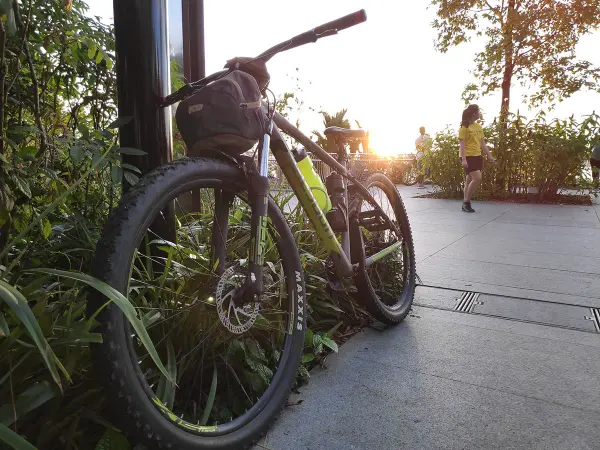
Sweat dripping, smiles wide, we stopped to chat with a group of first-timers. One rider, just as clueless about bikes as I was when I started, pointed to our rides and asked:
Mountain bikes skip kickstands for 2 reasons:
“My first bike, a trusty Polygon hardtail, was decked out for casual rides – a bell for friendly dings, derailleurs for effortless gear changes, and even a kickstand for convenient parking. Perfect for cruising the neighborhood, but on the trails? It was a disaster waiting to happen.
The first real rock feature, a monster lurking behind overgrown bushes, sent shivers down my spine. As I gingerly navigated the descent, my front wheel dropped, the kickstand snagged a rogue branch with a sickening THWACK!
Somehow, by some miracle, I stayed upright. That shaky moment, however, sealed the kickstand’s fate. It was ripped from the frame faster than you can say “trail upgrade.”
This close call made me realize the importance of kickstand safety on the trail and proper bolt tightening. But for serious mountain bikers, there’s a bigger reason they’re missing:
Every Ounce Matters On punishing climbs, mountain bikers morph into weight weenies, obsessed with shaving grams. A kickstand? Forget it! Those seemingly insignificant extras can steal your precious watts on a brutal ascent.
Imagine your lungs searing, legs screaming, clawing your way up that seemingly endless incline. Every gram counts, and ditching the kickstand could be the difference between pushing through or bonking.
Forget the kickstand! While convenient, they’re a mountain biker’s worst nightmare on the trail. Rough terrain translates to a vibrating bike, and a kickstand mounted on the chain stay becomes a noisy, nerve-wracking rattle trap.
Imagine a hidden rock or root catching that flimsy metal appendage – next thing you know, you’re over the bars. Accidental mid-ride deployment is another worry, disrupting your pedal stroke and potentially leading to a crash.
Mountain bike components are built tough to handle the abuse you throw at them, so ditch the kickstand and focus on conquering the trail, not wrestling with a potential hazard.
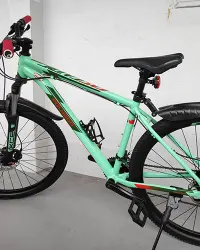
Mountain bikes ditch the kickstands – it’s all about keeping things lightweight and safe on the trail. But fear not, fellow shredders! We’ve got a toolbox of techniques to keep your trusty steed upright during rest stops.
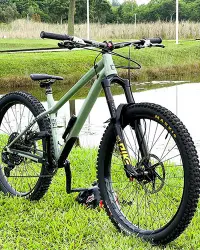
Leaning Machine:
Always on the lookout for a rest stop? Keep your eyes peeled for a sturdy tree, fence post, or large rock. Lean your trusty steed against it with the handlebars angled slightly away to create a stable base.
Bonus tip: Point the wheels downhill slightly for extra security on uneven ground! In a pinch, you can even use your backpack as a makeshift stand if you find yourself in an area without anything solid to lean on.
However, using your helmet for this purpose isn’t recommended. While it might work in a dire situation, helmets are designed for safety and could be compromised by repeated use as a lean.
Ground Game:
Quick breather time? No sweat! Simply lay your bike down gently on a flat, firm surface with the derailleurs facing upwards. This protects these delicate components from getting scratched or snagged on the ground.
While your handlebar grips might get a little dirty, it’s a minor consequence compared to the hassle of a damaged derailleur.

Bonus tip: If you’re really concerned about handlebar grip wear, consider a small, lightweight folding bike stand to keep your bike upright during short breaks.
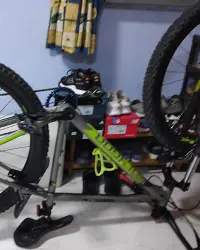
Soft Spot Solution:
Found yourself on a trail with no solid resting spots? Flip your bike upside down! Cradle the handlebars and seat on the ground, ensuring the wheels point upwards.
This technique works best on soft surfaces like grass or dirt to prevent your bike from sinking or tipping over. While you’re at it, you can do a quick inspection of your tires and brakes for any damage, or spin your back wheel, and enjoy the sound of hubs while admiring how gorgeous your bike looks.
Kickstands might be tempting in the concrete jungle, but ditch them for a more streamlined ride. Here are some clever tricks to keep your trusty steed upright during quick urban pit stops:
Curb Appeal:
Spot a curb or sturdy steps by the roadside? Lean your bike against it for a quick and stable rest.
Bonus Tip: Worried about scratching your pedals? Angle your bike slightly so the pedals have minimal contact with the curb.
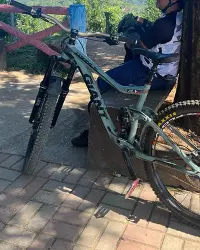
Step Up:
Need a one-handed stop? Simply turn a pedal and gently rest it on a step to prop your bike upright. This technique is perfect for grabbing a coffee or checking your phone.
Gear Up Stand:
No curb or step in sight? In a pinch, you can use your backpack as a makeshift stand. However, using your helmet for this purpose isn’t recommended.
Again, helmets are designed for safety and could be compromised by repeated use as a lean, but I sure do love to use them as they are so convenient.
You’ve crushed the trails, and now it’s time to pamper your trusty steed. For secure and convenient storage at home, consider investing in a bike stand (also known as a bike rack).
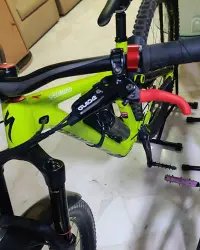
Floor stands are a popular choice for their versatility. They come in various designs, allowing you to easily adjust or move them around as needed. This flexibility is a lifesaver when rearranging your bike haven, especially if you have multiple bikes or host guests with their own rides.
Remember, mountain bikers are efficiency ninjas! These rest stop techniques will become second nature in no time.
Considering Convenience:
Let’s face it, kickstands offer a certain level of convenience. For casual riders or those using their mountain bike for commuting, a kickstand can be a lifesaver. Not every destination has designated bike parking, and leaning your bike against something might not always be an option.

But Weight Matters:
However, mountain bikers prioritize efficiency, and every gram counts. A kickstand adds unnecessary weight, which can be noticeable on climbs. It’s a trade-off: convenience versus performance.
Think Before You Drill:
If you decide a kickstand is essential, avoid permanent modifications! Drilling your frame weakens it and can compromise your bike’s integrity. Luckily, there are plenty of clamp-on kickstand options that won’t damage your precious steed. Learn from my friend’s misfortune – a DIY approach can be disastrous!
Forget the kickstand and unlock the secret weapon of casual riders – the “Bike Butler” technique! No need for advanced balancing like track stands. This simple method offers quick rests, especially on flat ground.
Here’s how to become your bike’s own support system:
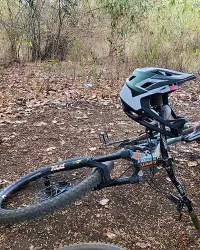
Voila! You’ve mastered the “Bike Butler” – a lightweight, snag-free
way to take a quick break. It might not win any elegance contests, but for
casual rides or photo ops with your mountain steed, this technique is a
lifesaver. Just remember, with great bike-holding power comes great
responsibility (don’t let it fall!).
So, next time you see a kickstand-less mountain bike, don’t judge! It’s a badge of honor, signifying a focus on performance and efficiency on the trails. Now that you’ve mastered the art of the lean and the “Bike Butler” technique, you’re ready to conquer any rest stop with confidence. Ditch the kickstand, embrace the lean, and shred those trails!
Join the Discussion:
Mountain bikers, we want to hear from you! Do you rock a kickstand, or are you a lean machine? If you do have one, what type works best for you? And for those who go kickstand-free, what’s your go-to rest-stop technique? Share your tips and tricks in the comments below!